| THE ING NEWSLETTER | No. 2, March 2000 |
|
|
SCIENCE |
|
|
|
| Previous: | The One Eye that Sees All: Integral Field Spectroscopy with SAURON on the WHT | Up: | Table of Contents | Next: | The Half Arcsecond Programme (I) |
Other available formats: PDF | gzipped Postscript
First Sodium Laser Beacon at La Palma
L. Michaille,
J. C. Quartel, J. C. Dainty, N. J. Wooder (Imperial College London), R.
W. Wilson (ATC), T. Gregory (ING)
In the ING Newsletter No. 1, an ongoing project to implement an adaptive optics system on the WHT was described. Called NAOMI (Nasmyth Adaptive Optics for Multiple Instrumentation), this system will be capable of eliminating, to a large degree, the image degrading effects of atmospheric turbulence.
As with any adaptive optics system, NAOMI will rely on measuring light from a relatively bright reference object, or "guide star", close to the desired target in order to make the necessary correction. At visible wavelengths, however, it is often not possible to find a sufficiently bright star in the neighbourhood of the astronomical region of interest. One would like to be able to simply dial-up a guide star exactly where it is needed, and this is possible with the use of a "sodium laser beacon".
At an altitude of 90km, well above the troublesome turbulence (which rarely reaches beyond 25 km altitude), is a 15 km thick layer of sodium atoms which, just as in a sodium lamp, can be excited to spontaneously emit light. To achieve this from the ground we can use a laser tuned to an absorption wavelength (589.0 nm) of the sodium atoms. The excited region of atoms creates a bright spot in the sky, the sodium laser beacon, which can be used as the guide star for an adaptive optics system (Figure 1).
A Laser Guide Star (LGS) system
is being planned for the WHT to compliment the NAOMI system. In preparation,
the Applied Optics group at Imperial College London has been investigating
some practical aspects of creating and using sodium beacons for adaptive
optics. Amongst these is a study of the sodium layer dynamics at La Palma
using observations of an experimental sodium laser beacon. We have built
a laser system which launches a 25 cm diameter, diffraction limited beam
from the liquid nitrogen building located roughly midway between the JKT
and the WHT (Figure 2). Part of the laser beam is directed through a small
sodium oven and by measuring the absorption we can lock the (tuneable)
laser output to precisely the correct wavelength for resonant excitation
of the sodium layer. The light scattered from our laser beam is shown in
Figure 3, an image taken in September 1999 from a 20 cm Meade telescope
3 m away from the launch. Above the long streak of Rayleigh backscatter
the sodium beacon is clearly visible. With only the slightest detuning
of the laser wavelength the sodium spot disappears.
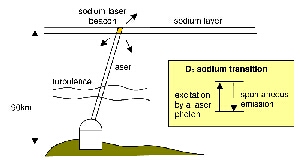 |
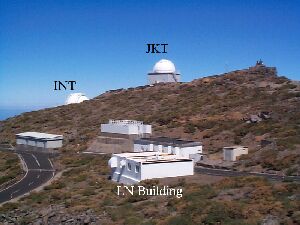 |
| Figures 1 and 2. Left: A laser, tuned exactly to the D2 transition of sodium, can be used to excite the sodium layer at 90km altitude. The beacon thus created can be used as the guide star for an adaptive optics system [ JPEG | TIFF ]. Right: The Liquid Nitrogen (LN) building which houses the laser. The beam is launched through a hole in the roof. [ JPEG | TIFF ] | |
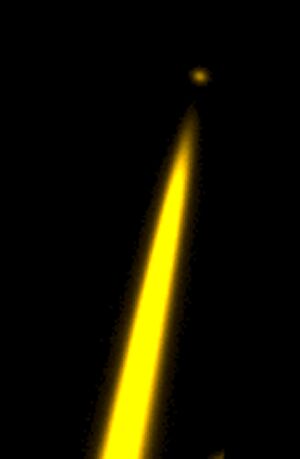 |
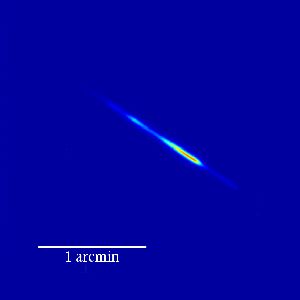 |
| Figure 3 (left). A pseudocolour image of the laser scattering taken with a small telescope 3m away from the laser launch. The small spot at the top is the sodium laser beacon [ JPEG | TIFF ]. Figure 4 (right). A pseudocolour image of the resonant backscatter from the sodium layer as viewed from the JKT at midnight 22 September 1999 [ JPEG | TIFF ] | |
Observing the sodium beacon from
the JKT, some 160 m away, gives a different perspective. Figure 4 shows
the long streak through the sodium layer created by the laser, with brighter
emissions from those parts of the layer more abundant with sodium. Analysing
the profile of these images allows us to measure fluctuations in the sodium
density profile above La Palma, on both minute-to-minute and season-to-season
time scales. In September 1999 we recorded some very interesting profiles.
Figure 5 depicts one night's data (22 September) and shows large, slow
variations in the shape and total area of the sodium profile, as well as
a sporadic event of high sodium concentration, lasting about 15 minutes,
in the upper part of the layer. While it is not certain what drives the
dynamics of the sodium layer, these variations must be taken into account
when designing a laser guide star adaptive optics system.
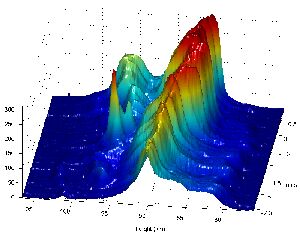 |
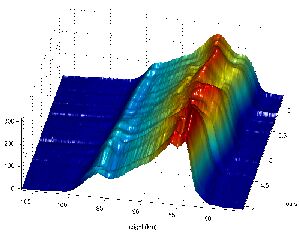 |
| Figure 5. Relative sodium density measured on 22 September 1999. (a) [ JPEG | TIFF ] and (b) [ JPEG | TIFF ] are early and late parts of the night, respectively. Time is indicated in hours from midnight. | |
The results shown here represent only part of our sodium monitoring campaign, which will also encompass observations in January, April, and June 2000 in order to measure seasonal variations in the layer. Along with our other related studies, this work paves the way for the construction of a laser guide star system for the WHT. Our present laser (an argon ion pumped ring dye laser) will not be used for this purpose as its 400 mW output power cannot produce a bright enough beacon for an adaptive optics system. With a more powerful laser system working in conjunction with the NAOMI adaptive optics system, the WHT will be placed in a highly competitive position against the larger 8 m class telescopes whose larger diameter makes the use of laser guide stars less effective.
Further information about this
and other related research can be found at http://op.ph.ic.ac.uk/.
Email contact: Laurent Michaille (laurent@op.ph.ic.ac.uk)
| Previous: | The One Eye that Sees All: Integral Field Spectroscopy with SAURON on the WHT | Up: | Table of Contents | Next: | The Half Arcsecond Programme (I) |
| GENERAL | SCIENCE | TELESCOPES AND INSTRUMENTATION | OTHER NEWS FROM ING | TELESCOPE TIME |